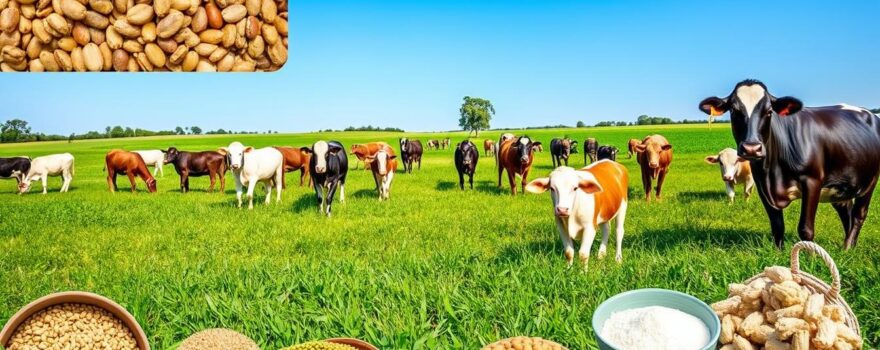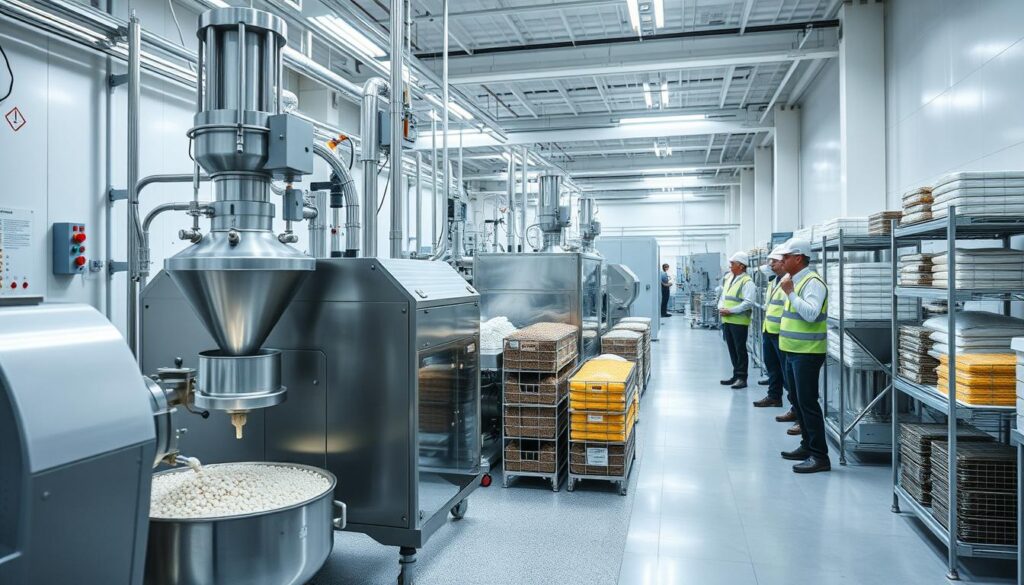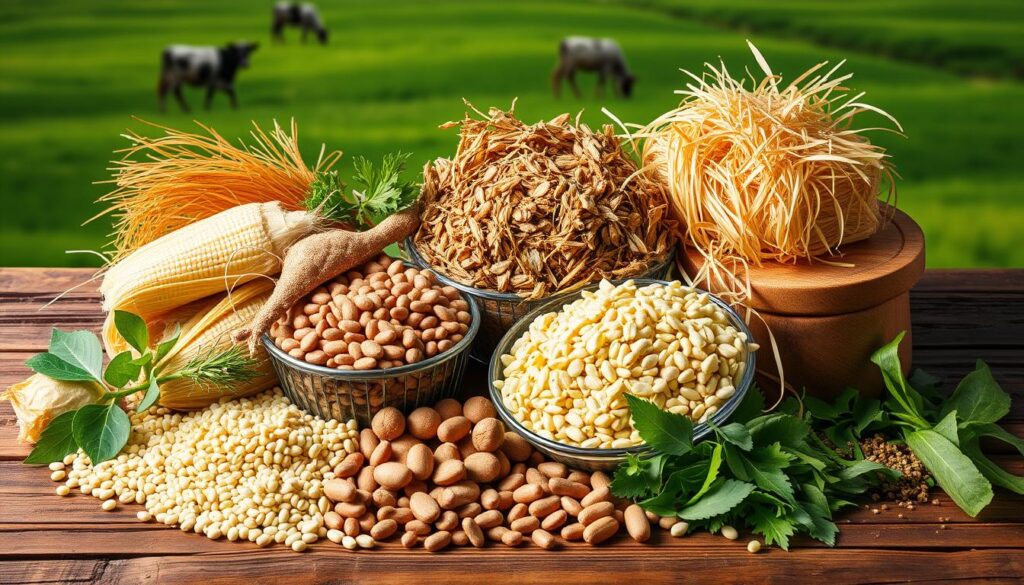
Making the right animal feed is key for healthy, growing livestock. Even experts can make mistakes that hurt animal health and profits. This guide will cover common feed formulation errors and how to dodge them.
If you raise livestock, make feed, or work in animal nutrition, this article is for you. It will help you improve feed quality and animal health. By learning about Livestock Nutrition, Feed Manufacturing, and Feed Quality Control, you’ll avoid common mistakes. This way, you can make better feed with confidence.
Key Takeaways
- Understand the common pitfalls in feed formulation and how to address them
- Learn to balance macro and micronutrients for optimal animal performance
- Implement effective ingredient selection and quality control measures
- Optimize feed efficiency through precision feeding and feed conversion ratio
- Identify and resolve nutrient deficiencies in livestock diets
Common Mistakes in Feed Formulation and How to Avoid Them
Making the perfect feed is tricky, even for experts. Mistakes like nutrient gaps and calculation errors can harm your animals. Knowing these issues helps you make better feed for your livestock.
One big mistake is not balancing nutrients right. Not knowing what each animal needs can lead to too much or too little of important nutrients. This can hurt growth, reproduction, and health.
- Learn about the specific needs of different animals, like poultry, swine, and ruminants, to avoid these problems.
- Test your feed ingredients often to check their quality and nutrient levels, as mistakes often come from bad data.
Another mistake is getting feed calculations wrong. This can mean too much or too little of key nutrients. Getting the balance right is key for good nutrition and feed efficiency.
| Nutrient | Recommended Range | Potential Consequences of Imbalance |
|---|---|---|
| Protein | 16-22% for poultry, 12-16% for swine, 12-14% for ruminants | Too little protein can slow growth and muscle build; too much can strain the animal and increase waste. |
| Energy (Calories) | Varies by species and production stage | Not enough energy can cause weight loss and lower productivity; too much can lead to obesity and health problems. |
| Calcium and Phosphorus | Ratio of 2:1 for poultry and swine, 1.5:1 for ruminants | Wrong balance can cause bone and skeletal issues, and problems with reproduction and metabolism. |
Fixing these common mistakes can make your animals healthier and more productive. This leads to better profits for you.
Understanding Feed Formulation Principles
Effective livestock nutrition starts with knowing how to formulate feeds. Different animals need different nutrients to stay healthy and grow well. By making feeds that match these needs, farmers can give their animals the best diet for their performance.
Nutrient Requirements for Different Livestock Species
Success in livestock nutrition comes from knowing what each animal needs. Whether it’s poultry, swine, or ruminants, knowing their nutrient needs is key. This lets farmers create feeds that meet the special needs of their animals.
Balancing Macro and Micronutrients
The art of feed formulation is balancing macro and micronutrients. Macronutrients like proteins, carbs, and fats give animals energy and help them grow. Micronutrients, like vitamins and minerals, are important for health and well-being. Getting these nutrients right is crucial for a good feed.
By understanding feed formulation, farmers can ensure their animals get the best diet. This knowledge helps them make better choices, improve animal health, and grow their business.
Ingredient Selection and Quality Control
In the world of livestock nutrition, the quality of feed ingredients is key. Feed Ingredient Quality, Feed Manufacturing, and Feed Quality Control are vital. They affect your livestock’s health and performance. Choosing the right ingredients and maintaining quality control are crucial for good nutrition.
When picking ingredients, it’s important to check their quality, safety, and fit. Livestock Nutrition experts suggest testing and analyzing each ingredient. This ensures they meet nutritional and safety standards.
- Analyze the macronutrient and micronutrient profiles of feed ingredients to ensure they align with the specific nutritional requirements of your livestock species.
- Assess the presence of any potentially harmful substances, such as mycotoxins, heavy metals, or pesticide residues, to safeguard the health of your animals.
- Verify the physical characteristics of the ingredients, such as particle size, texture, and moisture content, to ensure they are suitable for the feed manufacturing process.
Having a strong Feed Quality Control program is key. It involves strict testing and monitoring from start to finish. This ensures your feed is of the highest quality.
| Quality Control Measure | Purpose |
|---|---|
| Incoming Ingredient Inspection | Verify the quality and compliance of incoming feed ingredients |
| In-Process Monitoring | Ensure consistent product quality and identify any potential issues during manufacturing |
| Final Product Testing | Confirm the finished feed meets the desired nutritional and safety specifications |
By focusing on Feed Ingredient Quality and strong Feed Quality Control, you can improve the Feed Manufacturing process. This leads to better nutrition for your livestock, supporting their health and productivity.
Precision Feeding: Optimizing Feed Efficiency
Improving feed efficiency is key in animal nutrition. By focusing on the feed conversion ratio (FCR), producers can boost animal growth. This section looks at how to fine-tune feed to make the most of nutrients.
Feed Conversion Ratio and Growth Performance
The feed conversion ratio (FCR) shows how well animals use their feed. It’s about how much feed it takes to grow a certain amount of weight. By working on the FCR, producers can help animals grow better and use less feed.
To boost feed efficiency, try these tips:
- Make sure feeds match the needs of different animals at different stages.
- Use precise feeding methods like phase feeding to meet each animal’s needs.
- Keep an eye on growth and adjust feeding plans as needed.
- Improve feeding schedules and methods to cut waste and ensure steady nutrient intake.
| Livestock Species | Optimal Feed Conversion Ratio (FCR) | Factors Affecting FCR |
|---|---|---|
| Poultry | 1.6 – 1.8 | Genetics, Feed Formulation, Feeding Management, Environmental Conditions |
| Swine | 2.5 – 3.0 | Genetics, Feed Composition, Feeding Strategies, Health Status |
| Beef Cattle | 6.0 – 8.0 | Breed, Age, Diet Composition, Feeding Regime, Production Stage |
By using precision feeding and watching feed efficiency and growth performance, producers can use feed better. This leads to more productive animals and a more sustainable operation.
Addressing Nutrient Deficiencies in Livestock
Keeping livestock well-nourished is key for their health and success. Nutrient deficiencies can harm animals, affecting their growth and health. We will look at why these deficiencies happen and how to fix them through better feed.
Nutrient imbalances can come from bad feed, low-quality ingredients, or not enough supplements. These problems can cause slow growth, poor health, and make animals more likely to get sick. Knowing the signs of these issues helps farmers keep their animals healthy and productive.
Identifying and Addressing Nutrient Deficiencies
To tackle nutrient deficiencies, farmers should follow these steps:
- Keep an eye on the animals’ nutrition by testing their feed and blood, and watching for signs of illness.
- Change the feed to make sure it has the right mix of nutrients, like proteins, carbs, fats, vitamins, and minerals.
- Add special supplements to the feed to fix specific nutrient gaps, like extra calcium or phosphorus.
- Use top-quality feed ingredients to ensure the animals get the nutrients they need.
- Work with animal nutrition experts and vets to create feeding plans that fit each animal’s needs.
By tackling nutrient deficiencies early, farmers can improve their animals’ health and boost their farm’s success. It’s important to stay alert and use smart feed strategies to keep Livestock Nutrition at its best.
“Addressing nutrient deficiencies is a critical component of responsible and sustainable livestock production. By meeting the precise nutritional needs of our animals, we can maximize their health, productivity, and ultimately, our own profitability.”
Feed Manufacturing: Best Practices and Quality Assurance
Keeping feed quality and safety consistent is key in feed manufacturing. It involves precise nutrient balances and stopping cross-contamination. Feed makers must follow strict feed quality assurance and feed quality control steps. This ensures reliable and nutritious feed for livestock.
Maintaining Consistent Feed Quality
Quality feed starts with knowing what nutrients different animals need. Feed makers must pick top-notch ingredients and watch the feed manufacturing process closely. They need to test and check quality often to catch any problems early.
Preventing Cross-Contamination
Cross-contamination is a big worry in feed making. It can ruin the feed’s safety and nutrition. To avoid this, feed makers use strong quality control steps. They clean and sanitize well, and keep ingredients and finished products separate.
| Best Practices for Maintaining Feed Quality | Strategies for Preventing Cross-Contamination |
|---|---|
|
|
By following these best practices in feed manufacturing, producers can keep feed quality steady. This protects the livestock nutrition of their customers.

Feed Formulation for Poultry Production
Poultry production needs special Poultry Feed Formulation for chickens, turkeys, and other birds. It’s all about finding the right mix of nutrients, choosing the best ingredients, and how to make the feed. This way, producers can help their birds grow well, lay eggs, and stay healthy.
Getting the right balance of nutrients is key in Poultry Feed Formulation. Birds need the right amount of protein, energy, vitamins, and minerals. This ensures they grow well and stay healthy. The right mix can also fix problems like bad feed conversion and nutrient shortages.
Choosing the right ingredients is also important in Poultry Feed Formulation. Producers must pick high-quality grains, oilseeds, and proteins. Keeping a close eye on Feed Quality Control is vital. This ensures the birds always get the best nutrients.
The way feed is made is also crucial in Poultry Feed Formulation. Good mixing, pelleting, and storage keep the feed fresh and full of nutrients. Following best practices in making feed helps ensure it’s always of high quality. This supports the health and productivity of the birds.
“Optimizing poultry feed formulations is essential for maximizing the growth, egg production, and overall well-being of the flock. By carefully balancing nutrients, selecting quality ingredients, and implementing sound feed manufacturing practices, producers can unlock the full potential of their poultry operations.”
Swine Feed Formulation: Tailored Approaches
Making a good swine feed needs a careful plan that changes as pigs grow. Phase feeding is a key method used. It means changing the feed to match the needs of each growth phase. This way, pigs get the best nutrition and grow well.
Phase Feeding for Swine Nutrition
Swine need different things as they get older. Phase Feeding lets producers adjust the Swine Feed Formulation to meet these needs. It divides the growth into phases, so feed is made just right for each stage, from baby pigs to grown ones.
- Weaned piglets need different nutrients than growing finisher pigs.
- Phase feeding helps adjust the Swine Feed Formulation for better Feed Efficiency and growth.
- This method also keeps pigs healthy by avoiding too much or too little of any nutrient.
Using phase feeding, producers can give pigs the right nutrients at the right time. This boosts Livestock Nutrition and Feed Efficiency all through the swine cycle.
Ruminant Feed Formulation Considerations
Ruminant animals like cattle, sheep, and goats need special feeds. Their digestive systems are unique, requiring careful attention for their health and productivity. Key aspects of ruminant feed formulation include forage-based diets, balancing fiber and energy, and ensuring feed quality control.
Ruminants thrive on forage-based diets like grasses and legumes. High-quality forages are essential for their fiber and nutrients. This supports the rumen’s function and helps them efficiently convert plants into energy and nutrients.
The balance of fiber and energy in the feed is also crucial. Ruminants need a specific balance to maintain digestive health and performance. Proper feed formulation prevents issues like acidosis and bloat.
Ensuring feed quality control is vital in ruminant feed formulation. Monitoring feed ingredients’ nutritional and physical characteristics is key. This ensures a consistent, high-quality feed that meets the animals’ needs.
| Nutrient | Recommended Levels for Ruminant Diets |
|---|---|
| Crude Protein | 12-18% of total diet |
| Neutral Detergent Fiber (NDF) | 25-40% of total diet |
| Total Digestible Nutrients (TDN) | 60-72% of total diet |
| Calcium | 0.4-0.8% of total diet |
| Phosphorus | 0.2-0.5% of total diet |
Understanding ruminant nutritional needs is key to their health and productivity. By following best practices in feed formulation, you can support their well-being. Keeping up with research and industry standards is essential for success in ruminant feed formulation.

Cost-Effective Feed Formulation Strategies
In the world of livestock nutrition, finding affordable feed is a big challenge. But, by trying new ways and using different feedstuffs, we can make feeds that are both cheap and nutritious. This doesn’t mean we have to cut corners on animal health or performance.
Utilizing Alternative Feedstuffs
Using different feedstuffs is a smart way to save money. These can be co-products, by-products, or other ingredients that cost less than usual feeds. By checking their nutritional value and adding them to feeds, we can save a lot without losing quality.
For example, using waste like corn gluten meal or DDGS can be a cheap way to add important nutrients to animal diets. Also, using local ingredients can cut down on shipping costs and help the local economy.
| Feedstuff | Nutrient Composition | Potential Cost Savings |
|---|---|---|
| Corn Gluten Meal | High in Crude Protein (60-70%) | Up to 20% reduction in feed costs |
| DDGS | Good source of Protein, Fat, and Energy | 15-25% reduction in feed costs |
| Sorghum | Similar Nutrient Profile to Corn | 10-15% reduction in feed costs |
By looking at the nutrients, availability, and cost savings of different feedstuffs, we can make feeds that are cheaper and better for animals. This helps improve cost-effective feed formulation strategies, boosts livestock nutrition, and makes the feed manufacturing process better.
Regulatory Compliance and Feed Safety
Keeping up with regulations and ensuring feed safety are top priorities in the animal feed industry. Livestock nutrition and feed making follow strict rules to protect animals and people. By following these rules, feed makers can handle the complex world of feed regulations and focus on the safety and quality of their products.
Ingredient traceability is a big part of following regulations. Feed makers must track every ingredient back to its source. This helps solve problems quickly. They also need to monitor for harmful substances like mycotoxins or heavy metals in animal feed.
Right labeling and documentation are key to meeting rules and sharing clear info with livestock producers. Feed labels should show the nutritional content, how to use it, and any warnings. This ensures the product is used safely and effectively.
| Regulation | Key Requirements | Enforcement Agency |
|---|---|---|
| Food Safety Modernization Act (FSMA) | Establishes preventive controls and current good manufacturing practices for animal feed facilities | U.S. Food and Drug Administration (FDA) |
| Federal Insecticide, Fungicide, and Rodenticide Act (FIFRA) | Regulates the registration, labeling, and use of pesticides, including those used in animal feed | U.S. Environmental Protection Agency (EPA) |
| Veterinary Feed Directive (VFD) | Governs the use of medicated feeds and requires veterinary oversight for certain antimicrobial drugs | FDA |
By keeping up with changing rules and focusing on feed safety, feed makers can make sure their products meet all standards. This supports the health of livestock and keeps the food supply safe.
Emerging Trends and Innovations in Feed Formulation
The livestock industry is always changing, and feed formulation is no different. New ways are being found to meet animal nutrition needs and be more sustainable. One big trend is using alternative protein sources like insects, algae, and plants. These options help reduce the need for traditional protein-rich feeds.
Precision feeding technologies are becoming more popular. They let producers make feed that fits the exact needs of each animal or group. These systems use data and monitoring to improve feed use, cut down on waste, and boost herd performance.
Sustainability is a big focus in the industry, and feed formulation is leading the way. Formulators are looking into using upcycled and byproduct feeds. This approach helps lower the environmental impact of animal farming while keeping nutrition high. It’s key for meeting the demand for sustainable livestock products.